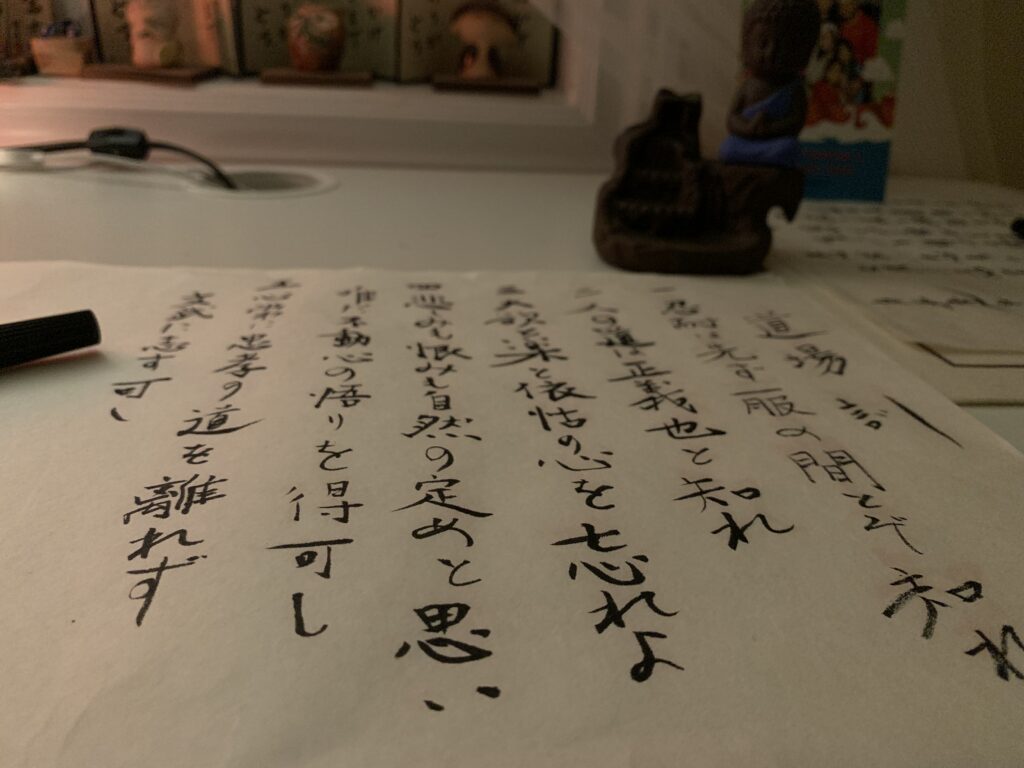A Beautiful Blend of Tradition and Expression:
Japanese culture is rich with traditions and practices that have captivated the world. Two such remarkable art forms, the way of the warrior and Japanese calligraphy, share a deep-rooted connection that spans centuries.
The samurai, renowned warriors of feudal Japan, embodied a strict code of conduct known as Bushido. This code emphasized honour, loyalty, and discipline, shaping the samurai’s way of life. Central to their training was the mastery of various martial arts, including swordsmanship, archery, and horseback riding. These arts were not only physical skills but also avenues for spiritual growth, fostering a deep connection between mind, body, and soul.
Japanese calligraphy, or Shodo, is a traditional form of writing that utilizes ink and brush to create intricate characters through various emotional engagements. It is more than just a means of communication; it is a form of artistic expression that requires concentration, precision, and an understanding of the beauty within each stroke. Calligraphy is deeply rooted in Zen Buddhism, emphasizing the importance of expressing mindfulness and the pursuit of inner peace through the act of writing.
Both samurai arts and Japanese calligraphy share fundamental philosophies that intertwine them. One of the fundamental principles of shodo is “ki-sho-ten-ketsu,” which represents the four essential elements: spirit, technique, paper, and ink. The spirit refers to the inner state of the calligrapher, their focus, and intention. Technique encompasses the mastery of brushstrokes and the ability to control the flow of ink. Paper plays a crucial role, as different types of paper absorb ink differently, resulting in varied textures and effects. Lastly, ink, traditionally made from soot and water, is the medium that brings the characters to life.
The art of Japanese calligraphy is deeply rooted in Zen Buddhism and the concept of “enlightenment through practice.” Calligraphers aim to achieve a state of “munen” or “no-mindedness” while creating their work. In this state, the calligrapher becomes one with the brush and the characters, allowing their inner thoughts and emotions to flow freely onto the paper.
Both emphasize the significance of discipline, focus, and the pursuit of perfection. They require practitioners to be fully present in the moment, channeling their energy and emotions into each movement or stroke. Both art forms also embody a sense of elegance and grace, with an emphasis on simplicity and harmony.
Just like In & Yo (Yin/Yang in Chinese) everything is interconnected and interdependent. The concept of “Bunbu Ryodo” also known as “Bunbu Ryoho,” is a concept rooted in Japanese culture that highlights the importance of balancing academic or literary pursuits (bun) with martial or military arts (bu). The term “bunbu” translates to “literary and martial” or “pen and sword” in English.
The idea of Bunbu Ryodo originated from Confucian philosophy, which emphasized the cultivation of both intellectual and physical abilities. It suggests that a well-rounded individual should strive for excellence in both scholarly and martial pursuits in order to achieve true personal development.
In the context of Bunbu Ryodo, “bun” represents the pursuit of knowledge, wisdom, and cultural refinement through activities such as literature, calligraphy, poetry, music, and painting. It encompasses the realm of intellectual and artistic endeavours that contribute to personal growth and the development of a cultured mind.
On the other hand, “bu” represents the development of physical strength, martial skills, and the ability to defend oneself. It encompasses practices such as swordsmanship, archery, horseback riding, and various martial arts disciplines. The study of martial arts not only cultivates physical abilities but also instills discipline, courage, and a sense of honor.
The concept of Bunbu Ryodo emphasizes the harmonious integration of both the “bun” and “bu” aspects in one’s life. It suggests that a person should strive to excel in both intellectual pursuits and physical endeavours, recognizing the interconnectedness and mutual benefit of each discipline.
Bunbu Ryodo has had a significant influence on Japanese society, particularly during the feudal era when the samurai class embraced this philosophy. It became a guiding principle for samurai warriors, who were expected to not only possess exceptional martial skills but also engage in cultural pursuits such as calligraphy, poetry, and tea ceremonies. By embodying both the pen and the sword, samurai strived to attain a balance between the art of war and the pursuit of knowledge.
Today, Bunbu Ryodo continues to be valued in various aspects of Japanese culture, including education, martial arts, and personal development. It serves as a reminder of the importance of cultivating diverse skills and knowledge, fostering a well-rounded individual capable of navigating different aspects of life with grace, wisdom, and strength.
Furthermore, both art forms require years of dedicated practice and training to master. Samurai spent countless hours honing their martial skills, while calligraphers devoted themselves to perfecting their brushwork and understanding the nuances of each character. Both demanded unwavering dedication, discipline, and a commitment to self-improvement.
The influence of samurai arts and Japanese calligraphy extends beyond their inherent beauty and skill. They have shaped Japanese society, fostering a deep appreciation for discipline, respect, and aesthetics. The principles embodied in these art forms continue to inspire individuals in various fields, from martial arts to literature and design.
The connection between samurai arts and Japanese calligraphy is a testament to the profound depth of Japanese culture. Both art forms embody the essence of discipline, focus, and the pursuit of perfection. They serve as reminders of the importance of mindfulness and the power of artistic expression in enriching our lives. The legacy of the samurai and the beauty of calligraphy continue to inspire and captivate individuals around the world, bridging the gap between ancient traditions and modern sensibilities.
By Eduard Divantman / 青龍

